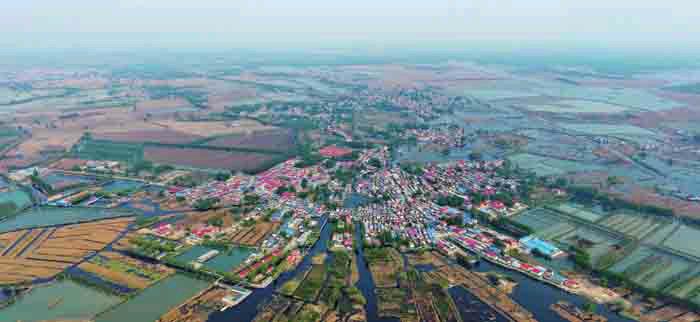Taking Shape
2017-10-22ByYuanYuan
By+Yuan+Yuan
Jiang Junming, a 54-year-old resident in Mazhuang Village of Rongcheng County, north Chinas Hebei Province, signed a provisional land contract with the local government on September 9. With this contract, he will get compensation of 4,147.5 yuan ($629) annually from his 1.75 mu (0.117 hectares) of farmland, which will be used for the site of the temporary offi ce of the Xiongan New Area Committee, until a formal land compensation policy is made by the administrative committee of the new area.
The site will occupy a total of 1,000 mu(66.67 hectares) of land, and 240 households from the village are affected. Jiang was the first to sign the contract, and another 239 followed suit.
This is also the first land contract in the Xiongan New Area since the State Council announced its establishment across three littleknown counties—Xiongxian, Rongcheng and Anxin—in Hebei Province on April 1.
Before a formal land compensation policy is made by the new area administrative committee, all the affected households can provisionally get 1,500 yuan ($227) per mu annually as land compensation and another 1,500 yuan in compensation for agricultural losses.
“The amount is greater than what I can earn from [growing] crops on the land,” Jiang told Xinhua News Agency. “I believe our life will be better in the future.”
“We are happy with the amount of the compensation,” Li Peiqin, another villager, told China Central Television. “The Xiongan New Area is a project for the new millennium, and I hope I can make some contributions to the construction.”
Setting on track
Right after the contracts were signed, the fi rst pile was driven deeply into the earth, thus kicking into gear the construction of the new area.
The temporary administrative center that is going to be built will include the Communist Party of China (CPC) working committee in Xiongan, its management committee and offices for some enterprises in the new area. It will also serve other functions such as hosting receptions, conferences and exhibitions.
After the plan for Xiongan was announced, the new area took the center of a shining stage that many are eyeing to see the following steps.
“We wont start any construction until we make a detailed plan for every inch of land in the new area,” Zhao Kezhi, Secretary of the CPC Hebei Provincial Committee, said at a conference on April 2.endprint
On June 26, the local authorities put the design of the new area out to tender and welcomed bids from global companies. By July 3, the initial application deadline, a total of 279 companies had submitted indications of interest. On August 20, 12 were selected for final consideration. The winning design is expected to be announced by the end of September.
The new area, whose aim is to help relieve the pressure on mega city Beijing by becoming a new home for Beijings noncapital functions, “will be a green, livable and modern urban area, a region led by innovation-driven development, a demonstration area of balanced development, and a pioneering region of open development,”according to Vice Premier Zhang Gaoli.
Zhang added that the development of the Xiongan New Area will explore new ways of addressing the problems of big cities, promote innovation and new growth engines, optimize the urban pattern, and bridge the gaps in economic growth and public services in the BeijingTianjin-Hebei region.
In its preliminary surveys, China Geological Survey, a research agency under the Ministry of Land and Resources, found the area is “very suitable for underground development” and suggested a tentative plan for subterranean space to be developed in two sections: surface to the depth of 26 meters underground and below 40 meters.
The higher section will be used for storage, shopping and entertainment complexes, parking and civil defense, while the lower section will carry pipes and transportation.
Deeper areas will also harbor water storage areas, important infrastructure and special projects including defense structures.
“That is to say, all the transportation, including buses and cars, will run underground; on the ground, you will only see pedestrians and green land,” Xu Kuangdi, Director of a council of experts for coordinated development of the Beijing-Tianjin-Hebei region, said on June 6.
On July 6, bullet trains connecting Beijing and the Xiongan New Area hit the track. The trip from Beijing to the Baiyangdian Lake, the largest lake in Hebei, takes about 80 minutes.
Green and ancient
Xiongxian County, known as the “capital of plastic products” in China, has more than 4,000 factories producing plastic products and occupies more than 90 percent of the industrys market share north of the Yangtze River. Environmental protection is a major concern of this area.
Laotouhe Town in Anxin County is one of the largest distribution centers of nonferrous metals in China, making it a big threat for the Baiyangdian Lake, located in Anxin.endprint
From the beginning of this year, the local government has been ramping up efforts to enhance Baiyangdians ecological environment by cleaning up the waterway, plugging sewage drain outlets and banning illegal sand mining activities.
The water quality upstream has since seen improvement after a total of 168 polluting drain outlets were blocked, and about 640,000 cubic meters of garbage-infested water were cleaned up, according to fi gures from the local government.
Most of the plastics factories and companies dealing with nonferrous metals in the area have been closed.
Figures from the environmental survey revealed not-so-bad fi gures. Of the over 1,400 square km of land the geological survey has investigated so far, more than 96 percent is free from heavy metal pollution, and about 13 percent is in good shape for farming.
There is “slight pollution” in underground water, with 98 percent from deep layers and 72 percent from shallow strata qualified as fit to drink after treatment.
With a recorded history of 10,000 years, Xiongan is also a place of archaeological importance.
Archaeologists have finished surveying heritage sites within a 200-square-km, medium-term development zone of the Xiongan New Area and compiled plans for their protection.
Among the most important findings were the Nanyang Ruins, the remains of an ancient city dating back to the Eastern Zhou Dynasty(770 -256 B.C.). Bronzeware and pottery were unearthed at this site and put under national cultural heritage protection.
Approved by the State Administration of Cultural Heritage, archaeologists will carry out detailed prospecting and trial excavations in the initial development zone. Meanwhile, they will continue surveying the medium-term development zone in 2018.
Population and housing
A report on the Xiongan New Areas population and housing policies released by the Chinese Academy of Social Sciences in August triggered debates about how many people the new area should have.
Now the population of Xiongxian is 390,000, that of Rongcheng is 260,000, and Anxin 390,000. The population density is relatively low, as the counties cover an area of 1,577 square km.
The development of Xiongan will happen in stages. It will start with an area of 100 square km, expand to 200 and eventually become 2,000. Accordingly, the initial population should be around 1 million, and in the long run, it should be limited to 5 million.endprint
“If 5 million people live in an area of 2,000 square km, the population density will be 2,500 per square km, which is even higher than that in Beijing,” Yang Kaizhong told China Economic Weekly. “That will be against the intention of building up Xiongan into a world-class ecological area. The Xiongan New Area should excel in terms of quality, not quantity and scale.”
Yangs opinion is also backed up by the fact that the Xiongan New Area is located in an area where water resources are quite limited.
Wang Hao, an academician of the Chinese Academy of Engineering, echoed Yangs opinion. “The Huaihe River Basin, where the Xiongan New Area is located, is one of the areas that suffer from the most serious water stress in the world,” Wang told China Economic Weekly. “The water resource per capita in this area is only 220 cubic meters. According to UN criteria, if the number is less than 500, the area is suffering from serious water shortage.”
Even if the population is limited to 3 million, there will be almost 2 million newcomers in the new area. “Rental housing will be common here, and it will leave no room for real estate speculation,” Liu Baoling, Executive Deputy Director of the Administrative Committee of the Xiongan New Area, told media on September 10.
A rental-sale integrated housing policy will be adopted, according to Liu. The sale of homes in Xiongan will be restricted for a period of time, but those that have been rented for more than 10 years will be allowed to go on sale.
“Xiongan will not follow the outdated urban development model dominated by the real estate industry,” Liu stated. “Homes in the Xiongan New Area are built for living, not for speculation.”endprint
